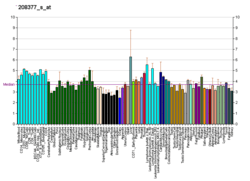Cav1.4
Cav1.4 also known as the calcium channel, voltage-dependent, L type, alpha 1F subunit (CACNA1F), is a human gene.[3]
This gene encodes a member of the alpha-1 subunit family; a protein in the voltage-dependent calcium channel complex. Calcium channels mediate the influx of calcium ions into the cell upon membrane polarization and consist of a complex of alpha-1, alpha-2/delta, beta, and gamma subunits in a 1:1:1:1 ratio. The alpha-1 subunit has 24 transmembrane segments and forms the pore through which ions pass into the cell. There are multiple isoforms of each of the proteins in the complex, either encoded by different genes or the result of alternative splicing of transcripts. Alternate transcriptional splice variants of the gene described here have been observed but have not been thoroughly characterized. Mutations in this gene have been shown to cause incomplete X-linked congenital stationary night blindness type 2 (CSNB2).[3]
See also
References
Further reading
- Catterall WA, Perez-Reyes E, Snutch TP, Striessnig J (2006). "International Union of Pharmacology. XLVIII. Nomenclature and structure-function relationships of voltage-gated calcium channels.". Pharmacol. Rev. 57 (4): 411–25. PMID 16382099. doi:10.1124/pr.57.4.5.
- Koenekoop RK, Lopez I, den Hollander AI, et al. (2007). "Genetic testing for retinal dystrophies and dysfunctions: benefits, dilemmas and solutions.". Clin. Experiment. Ophthalmol. 35 (5): 473–85. PMID 17651254. doi:10.1111/j.1442-9071.2007.01534.x.
- Tremblay F, Laroche RG, De Becker I (1995). "The electroretinographic diagnosis of the incomplete form of congenital stationary night blindness.". Vision Res. 35 (16): 2383–93. PMID 7571473. doi:10.1016/0042-6989(95)00006-L.
- Bergen AA, ten Brink JB, Riemslag F, et al. (1995). "Localization of a novel X-linked congenital stationary night blindness locus: close linkage to the RP3 type retinitis pigmentosa gene region.". Hum. Mol. Genet. 4 (5): 931–5. PMID 7633454. doi:10.1093/hmg/4.5.931.
- Hillier LD, Lennon G, Becker M, et al. (1997). "Generation and analysis of 280,000 human expressed sequence tags.". Genome Res. 6 (9): 807–28. PMID 8889549. doi:10.1101/gr.6.9.807.
- Bergen AA, ten Brink JB, Riemslag F, et al. (1997). "Conclusive evidence for a distinct congenital stationary night blindness locus in Xp21.1.". J. Med. Genet. 33 (10): 869–72. PMC 1050769
 . PMID 8933343. doi:10.1136/jmg.33.10.869.
. PMID 8933343. doi:10.1136/jmg.33.10.869. - Fisher SE, Ciccodicola A, Tanaka K, et al. (1998). "Sequence-based exon prediction around the synaptophysin locus reveals a gene-rich area containing novel genes in human proximal Xp.". Genomics. 45 (2): 340–7. PMID 9344658. doi:10.1006/geno.1997.4941.
- Strom TM, Nyakatura G, Apfelstedt-Sylla E, et al. (1998). "An L-type calcium-channel gene mutated in incomplete X-linked congenital stationary night blindness.". Nat. Genet. 19 (3): 260–3. PMID 9662399. doi:10.1038/940.
- Bech-Hansen NT, Naylor MJ, Maybaum TA, et al. (1998). "Loss-of-function mutations in a calcium-channel alpha1-subunit gene in Xp11.23 cause incomplete X-linked congenital stationary night blindness.". Nat. Genet. 19 (3): 264–7. PMID 9662400. doi:10.1038/947.
- Naylor MJ, Rancourt DE, Bech-Hansen NT (2000). "Isolation and characterization of a calcium channel gene, Cacna1f, the murine orthologue of the gene for incomplete X-linked congenital stationary night blindness.". Genomics. 66 (3): 324–7. PMID 10873387. doi:10.1006/geno.2000.6204.
- Boycott KM, Pearce WG, Bech-Hansen NT (2000). "Clinical variability among patients with incomplete X-linked congenital stationary night blindness and a founder mutation in CACNA1F.". Can. J. Ophthalmol. 35 (4): 204–13. PMID 10900517. doi:10.1016/s0008-4182(00)80031-9.
- Boycott KM, Maybaum TA, Naylor MJ, et al. (2001). "A summary of 20 CACNA1F mutations identified in 36 families with incomplete X-linked congenital stationary night blindness, and characterization of splice variants.". Hum. Genet. 108 (2): 91–7. PMID 11281458. doi:10.1007/s004390100461.
- Wutz K, Sauer C, Zrenner E, et al. (2003). "Thirty distinct CACNA1F mutations in 33 families with incomplete type of XLCSNB and Cacna1f expression profiling in mouse retina.". Eur. J. Hum. Genet. 10 (8): 449–56. PMID 12111638. doi:10.1038/sj.ejhg.5200828.
- Weleber RG (2002). "Infantile and childhood retinal blindness: a molecular perspective (The Franceschetti Lecture).". Ophthalmic Genet. 23 (2): 71–97. PMID 12187427. doi:10.1076/opge.23.2.71.2214.
- Zito I, Allen LE, Patel RJ, et al. (2003). "Mutations in the CACNA1F and NYX genes in British CSNBX families.". Hum. Mutat. 21 (2): 169. PMID 12552565. doi:10.1002/humu.9106.
- Jacobi FK, Hamel CP, Arnaud B, et al. (2003). "A novel CACNA1F mutation in a french family with the incomplete type of X-linked congenital stationary night blindness.". Am. J. Ophthalmol. 135 (5): 733–6. PMID 12719097. doi:10.1016/S0002-9394(02)02109-8.
- Jalkanen R, Demirci FY, Tyynismaa H, et al. (2003). "A new genetic locus for X linked progressive cone-rod dystrophy.". J. Med. Genet. 40 (6): 418–23. PMC 1735490
 . PMID 12807962. doi:10.1136/jmg.40.6.418.
. PMID 12807962. doi:10.1136/jmg.40.6.418. - Koschak A, Reimer D, Walter D, et al. (2003). "Cav1.4alpha1 subunits can form slowly inactivating dihydropyridine-sensitive L-type Ca2+ channels lacking Ca2+-dependent inactivation.". J. Neurosci. 23 (14): 6041–9. PMID 12853422.
- Nakamura M, Ito S, Piao CH, et al. (2003). "Retinal and optic disc atrophy associated with a CACNA1F mutation in a Japanese family.". Arch. Ophthalmol. 121 (7): 1028–33. PMID 12860808. doi:10.1001/archopht.121.7.1028.
- Kotturi MF, Carlow DA, Lee JC, et al. (2004). "Identification and functional characterization of voltage-dependent calcium channels in T lymphocytes.". J. Biol. Chem. 278 (47): 46949–60. PMID 12954628. doi:10.1074/jbc.M309268200.
External links
- GeneReviews/NCBI/NIH/UW entry on X-Linked Congenital Stationary Night Blindness
- CACNA1F protein, human at the US National Library of Medicine Medical Subject Headings (MeSH)
This article incorporates text from the United States National Library of Medicine, which is in the public domain.
